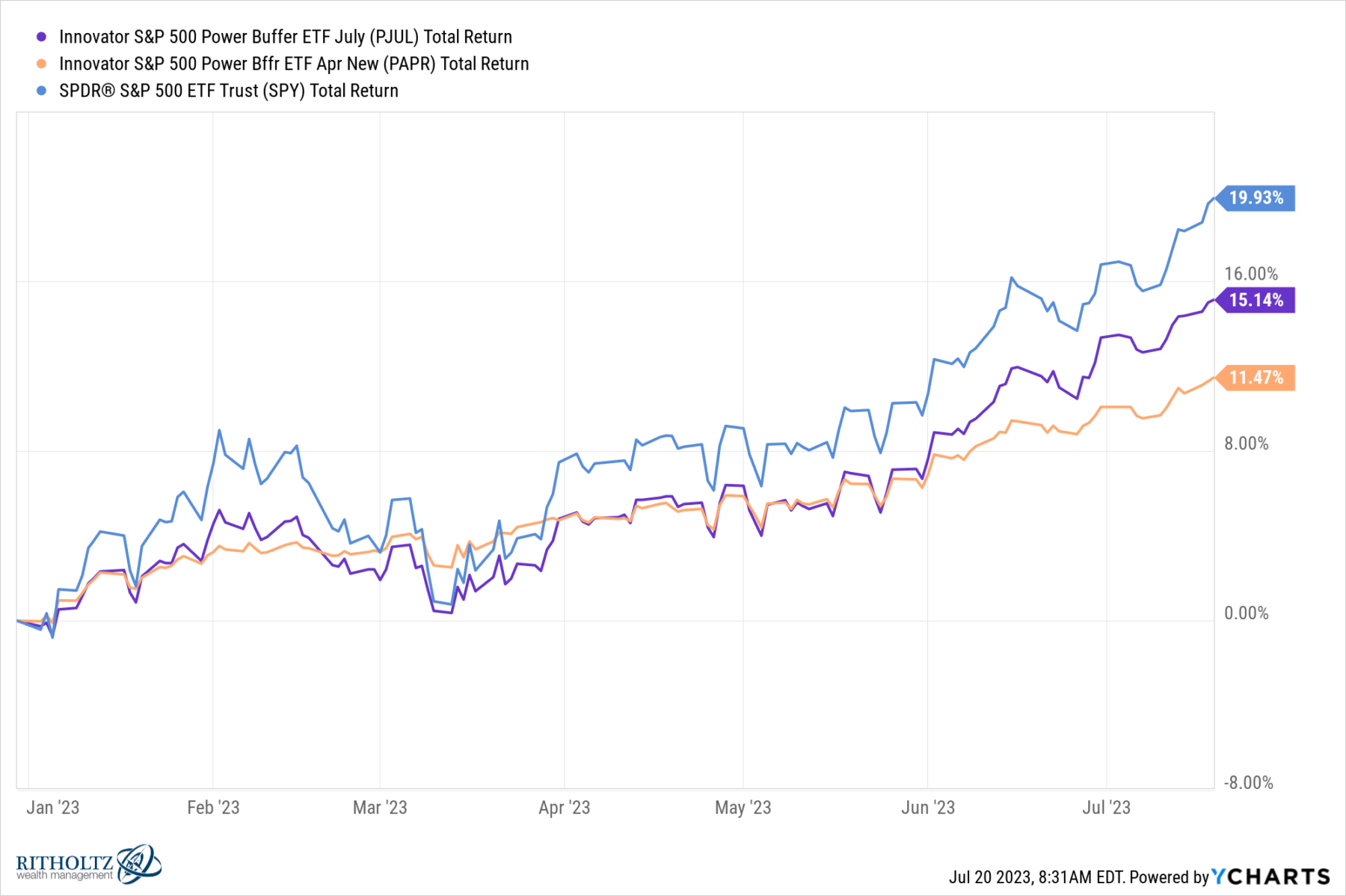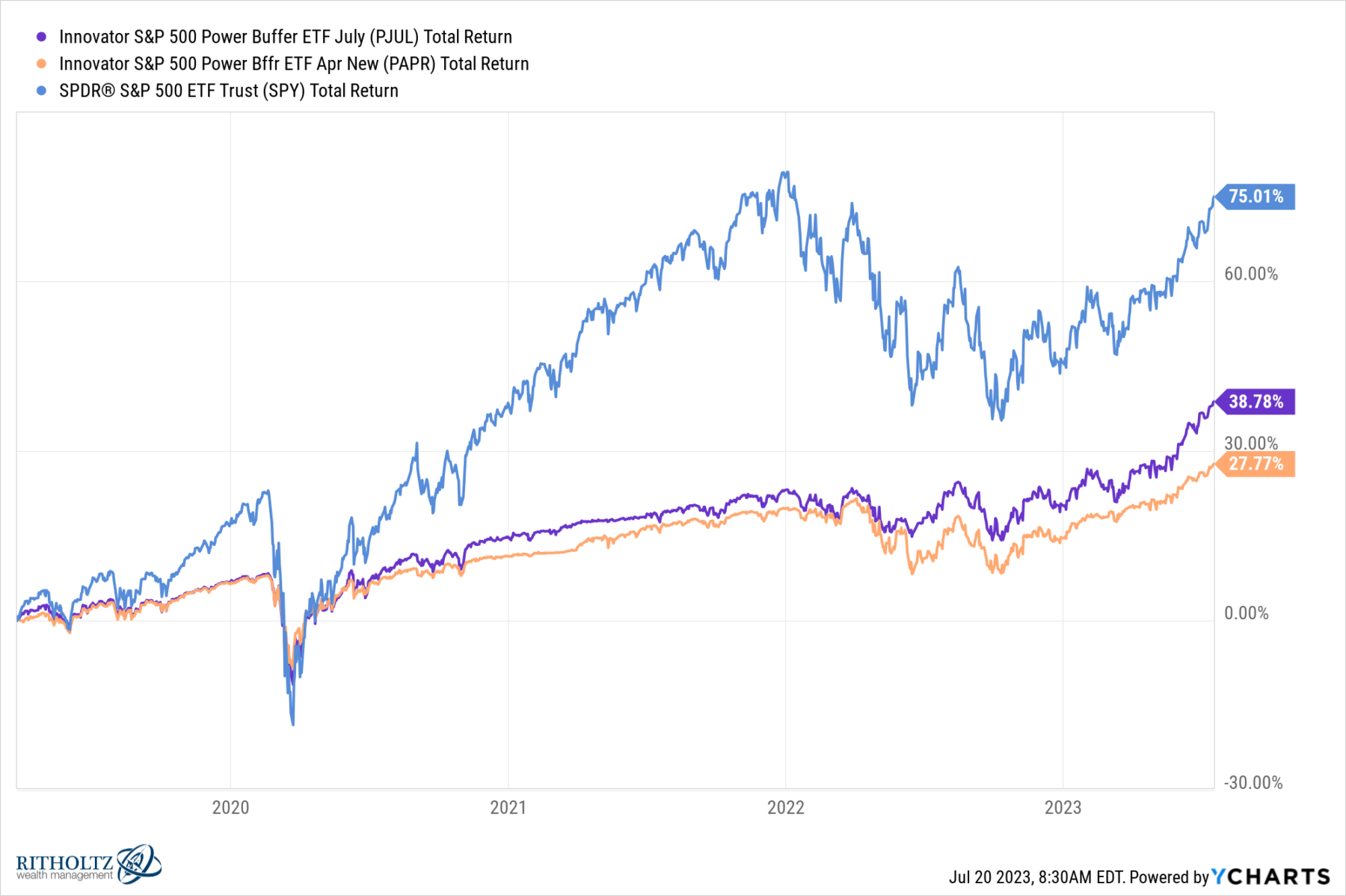“A new product that offers investors complete downside protection: Investors in the $7.5 trillion ETF universe can now put money behind the Innovator Equity Defined Protection ETF, which began trading under the ticker TJUL on Tuesday. The offering comes from Innovator Capital Management, which launched the first so-called buffer ETFs, also sometimes referred to as defined-outcome funds, in 2018.” –Bloomberg
Let’s get this out of the way: I dislike any product that exchanges a portion of your potential gains in exchange for downside protection.
Let’s discuss why.
First and foremost, products like these are wholly unnecessary. At least, if you are a smart investor who does the right things: Set up a financial plan, manage your own behavior, engage in long-term thinking, and avoid reacting to the endless daily noise that markets + media generate.
Second, follow Charlie Munger’s advice and invert the sales pitch: 70% of the upside (you give up 16.62% per year for 2 years) with none of the downside sounds attractive – unless you think about what you are really giving up and getting in exchange.
Would you accept a trade where for ~32% of the upside, you are freed from having to manage your own behavior? That sounds quite expensive for something that should cost you a) nothing if you do it yourself, or 2) 50-100 bps if you work with an advisor.
That sounds like a terrible deal to me.
Third, when you own a broad index of equities, the upside compounds over the long run while the drawdowns are temporary. Giving up permanent gains to avoid impermanent drops seems like an awful exchange.
My obvious bias is that my advisory firm charges clients to create financial plans and manage their assets. But just do the math: Would you prefer to give up 67 basis points (RWM’s dollar-weighted average fee is ~0.67%) or would you prefer to give up 30% of your gains PLUS pay an annual 0.79% fee for the TJUL ETF? It is the advisor’s job to prevent clients from engaging in the kind of bad investment behavior that drawdowns often cause; I cannot see how trading that for >30% of the upside makes any sense.
Innovator, the firm behind TJUL, manages “more than 50 buffer funds which have collectively drawn over $12 billion in assets since 2018. . . Among the largest vehicles are the Innovator S&P 500 Power Buffer ETF (PAPR), totaling about $687 million in assets, and the Innovator S&P 500 Power Buffer ETF (PJUL), which has roughly $834 million in assets.”
Those funds have a starting upside cap of 14.28% versus TJUL’s 16.62%; the chart above shows how they have done year to date: Up 11.5% and 15.1% respectively this year, versus 19.9% for SPY. Since inception (March 2019), they are up 27.8% and 38.8% respectively, versus 75% for the SPY S&P 500 ETF over the same period. (Chart after the jump).
The performance numbers reveal this is a terrible trade-off for the average long-term retail investor.
~~~
UPDATE: July 21, 2023
This question comes in: What is the appropriate use case for a product like this?
The obvious answer: Cash that is set aside for a specific purpose at a known near-term date, where losses — even temporary drawdowns — are unacceptable. I could imagine saving cash for:
– A down payment to buy a house.
– A child’s short term needs, such as paying for a Wedding in a year
– Year end bonus that will go to the IRS on April 15;
In all of these circumstances, where losses are deeply problematic and the alternatives are unattractive (e.g., 4% taxable money market account), for the cash described above, this makes some sense.
My concern here is that long-term investors will use these products inappropriately, not that the products themselves are corrupt. I can see how these products serve a real niche that my buddy and ETF wizard Dave Nadig suggests may be as large as $100 billion or more.
Dave references a friend with a $100k slug he needs back out in 4 years; the guy “really, really wants to be in the market,” but does not have the time to pay much attention, won’t hedge with a Put portfolio himself, and the assets are not large enough to have a meaningful conversation with an advisor. This product makes sense for a guy like that. Sure, it’s pricey at 79 bps, but what managed option ETF is cheap?
I just hope the ETF does not get marketed to the wrong people…
See also:
Innovator TJUL
Source:
Wall Street Gets New ETF Offering 100% Downside Protection
By Vildana Hajric, and Emily Graffeo
Bloomberg, July 18, 2023
PJUL, PAPR, SPY March 25 2019 to July 10, 2023 (yesterday’s market close)



